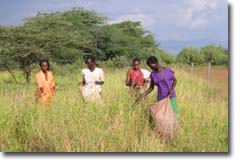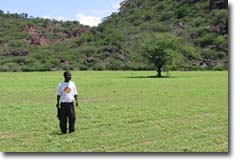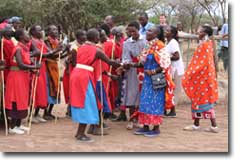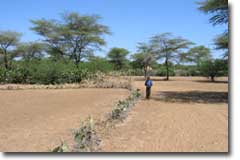|
|
Home > Activities
> Community
Management
|
Sustainable management of reclaimed land is only
practiced if benefits and profits are realised, while
profits are only realised if land is managed on a
sustainable basis.
|
|
Building community capacity to manage their
improved resources on a sustainable basis requires
long term training and follow-up. Although complex
community dynamics make larger reclaimed communal
areas more challenging to manage, smaller private
areas cannot sustain dryland communities in isolation.
In both cases, the key to sustaining reclaimed areas
is that communities and individuals benefit directly
from their improved land and livestock management
practices.
|
Communal
field Management:
RAE began by planting larger communal fields, of
over 470 acres, in 1982. Today
there are 38 reclaimed communal fields and
extensions totaling over 3340 acres in
Baringo and Laikipia. RAE long term experience and
data demonstrate the many challenges involved in
establishing sustainable management systems of
communal fields with diverse communities. This is
especially true in areas such as Baringo, where
community cohesion has broken down due socio-economic
changes and modern influences. |
|

Communal field managed by
women's shareholder group
|
To
date, the tighter more intensive management by
smaller, well defined groups has proven to be far more
effective than management by the wider (often
amorphously defined) communities. Almost all the
communal fields are now managed by shareholder groups,
with each member paying a share, as agreed upon by the
group, as well as a smaller registration fee. As
shareholders, members have rights to field benefits,
but they are also directly responsible for managing
field initiatives. There are typically six
elected officers per shareholder group with
re-elections taking place when terms are over.
Generally, larger communal fields have between 30-40
shareholder members, and smaller fields have between
15-20 members. Shareholder groups main
responsibilities include, writing a charter of
by-laws, keeping transparent accounts, managing and
recording income generating activities and group
participation, as well as registering the group with
the government. RAE continues to work with and
train all groups, which are at different stages of
development and have varying management strengths and
weaknesses.
 |
|
Private Field Management:
RAE began planting private fields in 1994 with four
fields reclaimed on an experimental basis for four
field owners. Today over 240 field owners
scattered throughout the Baringo basin manage over 400
reclaimed private fields, totaling approximately 680. Currently, RAE reclaims an approximate 100
private fields per year, varying in size from less
than one acre to over 20 acres. Requests often
exceed RAE capacity, and figures do not include the
growing numbers of individuals and organisations that
purchase grass seed for planting in other dryland
areas. |
|

Monitoring freshly germinated grass
on newly planted private field
|
Private
field owners and their families clear, fence, manage
and sustain their own grass fields. RAE carries out
extensive training, monitoring and evaluation of
private fields, especially just after planting to
ensure that fields are not grazed until after the
grass has seeded. Specific fields are followed on a
regular basis in regards to benefits and
sustainability. The dissemination of lessons learnt
from local owners using innovative management
strategies that generate income has led to a wider
application of improved strategies by both private and
communal field owners.
 |

Exchange tours with other
semi-pastoralist groups are key to RAE's
expansion
|
|
Sustainable
Expansion: Recognising the success of RAE’s
work, many local groups and individuals from inside
and outside the wider Baringo area have requested
RAE's assistance in the reclamation of their degraded
lands. Requests often stem from successful exchange
tours with semi- pastoralists, and have included
groups from
Laikipia, Northern Kerio, West Pokot, Maasai, Machakos
and Turkana. The number of
requests that can be fulfilled, and the extent the
programme can be expanded, depends directly on
the financial and resource capacity available. |
Land
Tenure / Ownership Issues: Most dryland
areas of Kenya are communally owned and held in trust
by the Government of Kenya. Although official
government policies are currently under review, land
tenure and use rights are in most cases defined by the
local people themselves and differ from one area to
another. In the Baringo lowlands, for example,
community members have started to demarcate their own
individual 'private' pieces of land, originally to
plant maize, but more recently to plant grass.
Although officially unrecognised, this people driven
'private' ownership system continues to gain momentum,
especially in the dryland areas of Baringo where Group
Ranches are dysfunctional and administrative and
ethnic boundaries remain ill defined.

|

The demarcation of 'private'
land by people in Baringo
|
|
The
legal reform of land tenure and ownership issues lies
at the heart of conflict resolution and securing
viable management systems in Baringo and other dryland
areas. It is essential that this process is
community-based and carried out with real sensitivity
and in-depth knowledge of the environmental and social
dynamics of each local area. The current community
trend in Baringo of relating land demarcation and
ownership directly to improved land use and management
practices may become an important example to follow in
other areas. |
|
In Baringo, a policy linking land ownership
directly to sustainable land reclamation of both
private and communal areas would make this possible.
RAE is currently working with the local people, other
organisations and the Kenyan Government to promote
such a policy, and develop a natural resource plan for
the wider Baringo basin.
|
|